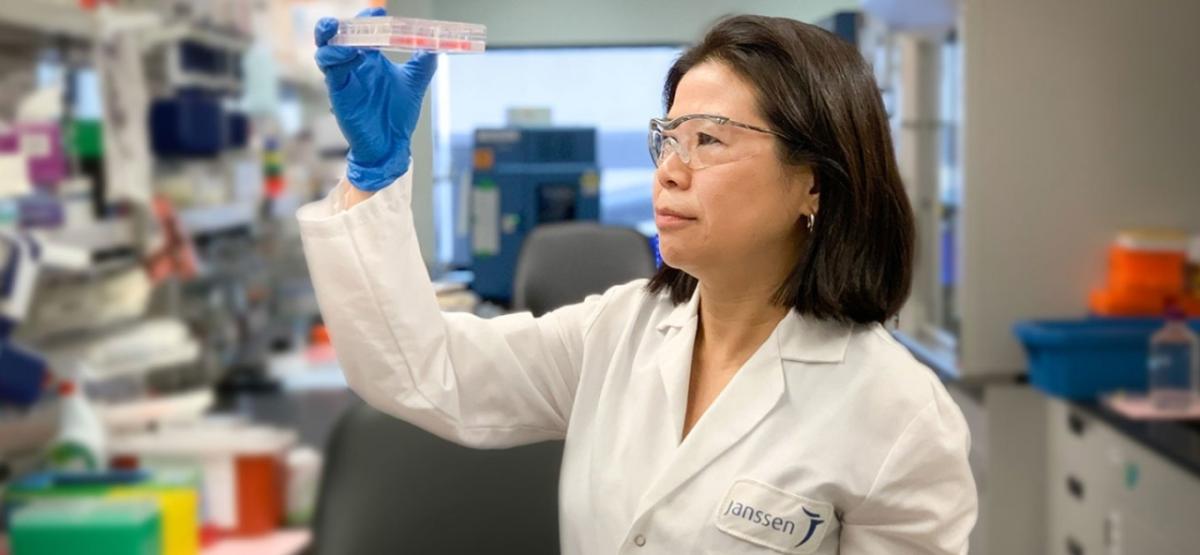From Doctor to Researcher: Meet a Woman Who's Spent Much of Her Career Fighting Prostate Cancer
For Prostate Cancer Awareness Month, we sat down with Margaret Yu, M.D., Vice President, Disease Area Leader, Prostate Cancer, Janssen Research & Development, to learn more about the latest scientific strides being made in the battle against one of the mo

By Darren Frei
There’s promising news in the fight against prostate cancer: According to a recent study conducted by the American Cancer Society, incidence of the disease—as well as deaths from prostate cancer—have been decreasing or stabilizing in most countries around the world.
And while the disease still remains the most common cancer in American men after skin cancer, overall outcomes are improving and “many patients are living longer lives,” explains Margaret Yu, M.D., Vice President, Disease Area Leader, Prostate Cancer, Janssen Research & Development, LLC, one of the Janssen Pharmaceutical Companies of Johnson & Johnson.
Better screening is one reason why these statistics are improving, but treatment advancements are also helping change the landscape for prostate cancer patients.
For Prostate Cancer Awareness Month, we sat down with Dr. Yu to learn more about the disease, who is at risk and what kind of research could potentially help lead to a cure.
Q: Why are you so passionate about working on treatments for prostate cancer?
A: Sixteen years ago, during my first two years as an attending physician, I was a Veterans Affairs-appointed doctor and I spent a lot of time treating patients with prostate cancer.At that time, there were limited treatment options. If a patient had a certain type of the disease—metastatic castration-resistant prostate cancer—it meant that prostate-specific antigen (PSA) levels were rising, hormone treatments were no longer working, and the disease had spread beyond the pelvis. For these patients, the next step might have been chemotherapy and perhaps radiation or other supportive or palliative care. But at a certain point, we knew there were no more treatments to try, and the patient was going to die. It was incredibly depressing to me.
That’s why I’m so excited to be part of researching treatments today. Prostate cancer is very complicated, and while there have been advances, there’s still a huge unmet need in terms of treatment options. This is why we work so hard, and this is what motivates me to help drive new advancements.
Q: What do we now know about who is more likely to get prostate cancer?
A: Prostate cancer tends to affect older men, with about 6 in 10 cases being found in men beyond the age of 65. It also occurs more frequently in African American men and in Caribbean men of African ancestry, although the reason is unclear.After lung cancer, prostate cancer is the second leading cause of cancer death in American men. And while most men diagnosed with prostate cancer don’t die from it anymore, it’s a good idea to discuss risk factors with your doctor sooner rather than later.
There is a strong genetic component to prostate cancer risk, so if you have a family history of it, you may need to begin having examinations earlier than other men, and discuss with your doctor what the right prevention plan might be for you.
Q: What are some of the ways that prostate cancer is currently treated?
A: Treatments can include watchful waiting, active surveillance, surgery, chemotherapy, radiation treatments and hormone therapy.There are, for example, hormonal therapies focused on a group of hormones called androgens, which includes testosterone. Androgens can make prostate cancers grow wildly. New hormonal therapies called androgen receptor-directed therapies can inhibit the production of androgens or block them from sending the growth message to cells, resulting in tumor shrinkage or slower tumor growth.
When these treatments were first developed, researchers and oncologists hoped they would enable patients to go into long-term remission—and today we have powerful ones that can do just that. The new androgen receptor-directed therapies are currently being used to help some patients with non-metastatic, castration-resistant prostate cancer by helping delay the spreading of the disease.
Now researchers are studying how these types of hormone therapies could be used even sooner to treat the early stages of the disease.
Q: What are you most hopeful about when it comes to the future of treatment for prostate cancer?
A: There are many different types of prostate cancer, but we tend to treat them all the same way because there still aren’t that many treatment options directed to the different types. That’s why scientists are so eager to find new tools to battle the disease. The more we learn about how prostate cancer is segmented, the better we will be able to develop specific therapies that can treat each type.One thing we do know is that prostate cancer requires the androgen receptor for its survival. So perhaps the answer might be for researchers to keep working until they figure out a way to get rid of the androgen receptor altogether. Or a cure may come from discovering an entirely new way to attack prostate cancer.
Q: What do you want people to know if they or a loved one has been diagnosed with prostate cancer?
A: I’d tell them that the medical community is making great strides in fighting the disease. Today we’re making serious headway toward figuring out how to make prostate cancer a truly chronic disease—meaning it is something that can be managed.Of course, the ultimate goal for researchers like myself and the ones working here at Janssen is to cure prostate cancer completely. That’s what all of us are truly fighting for.

